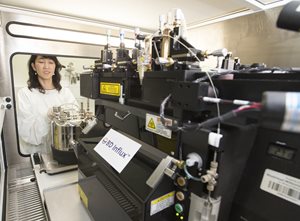 It is widely used in biomedical research, as well as for environmental testing and monitoring. Some typical applications include monitoring patients in clinical trials evaluating animals in pre-clinical studies or animal models of malignancy; examining cell-cell interactions; studying the biology of cells and interactions of proteins within cells, finally collecting the cell populations for the further study or diagnostic purposes.
It is widely used in biomedical research, as well as for environmental testing and monitoring. Some typical applications include monitoring patients in clinical trials evaluating animals in pre-clinical studies or animal models of malignancy; examining cell-cell interactions; studying the biology of cells and interactions of proteins within cells, finally collecting the cell populations for the further study or diagnostic purposes.
Flow cytometry typically uses fluorescence probes which bind to specific cell-associated molecules. As the cells flow past a focused laser beam of appropriate wavelength, the probes’ fluorescence and emitted light is collected and directed to appropriate detectors. These detectors, in turn, translate these light signals into electronic signals proportional to the amount of light collected.
The relative size and granularity of a cell is also measured by the flow cytometer because these characteristics can influence the way in which light is scattered as the cell passes through the laser beam.
Flow Cytometry at the Westmead Institute
The use of flow cytometry at The Westmead Institute can be divided into two broad categories: analysis and cell sorting.
Analysis
The ability of flow cytometers to evaluate single cells using multiple parameters (up to 20) at an extremely rapid rate (e.g. up to 10,000 events per second) makes this technology ideally suited for the reliable and accurate quantitative analysis of selected physical properties of cells of interest. The sensitivity of these instruments for detecting the presence of molecules expressed at low levels is impressive. Depending on the quality of cell preparations and reagents, as few as 500 molecules per cell may be detected.
Cell Sorting
One of the properties of the cell sorter is the ability not only to detect but to electronically deflect cells which have preset, defined properties into a separate collection tube. For cell purification, flow cytometry is especially well suited for applications requiring high purity (>99%). Because up to 21 distinct fluorescent probes reacting with different cell associated molecules can be assessed simultaneously at this facility, cell sorting by flow cytometry can not only separate complex mixtures of cells on the basis of multiple marker expression but collect multiple cell populations (up to 6 populations) at the same time.
About our Flow Cytometry Laboratory
The flow cytometry lab at the Westmead Institute is part of the Westmead Research Hub core facilities. It serves over 180 active researchers from over 40 research groups across the Hub and other research locations including Nepean Hospital and the Ingham Institute.
Established in 2000, this flow cytometry facility was completely upgraded in 2012 with an fully automated magnetic cell separator, four international-standard flow cytometry analysers and two high-end cell sorters, offering users cutting- edge cytometry equipment and resources.
The technology of flow cytometry is rapidly growing and highly technical. The Westmead Institute’s facility is staffed by two flow cytometry experts committed to providing training and education for all the laboratory users. In addition, facility staff perform cell sorting experiments as well as provide advise and assist researchers with:
- Multiparameter flow cytometry experiment and panel design
- Gating strategies and data analysis
- Protocols and procedures for new cytometry based assays
- Complex cell sorting strategies including single cell sort